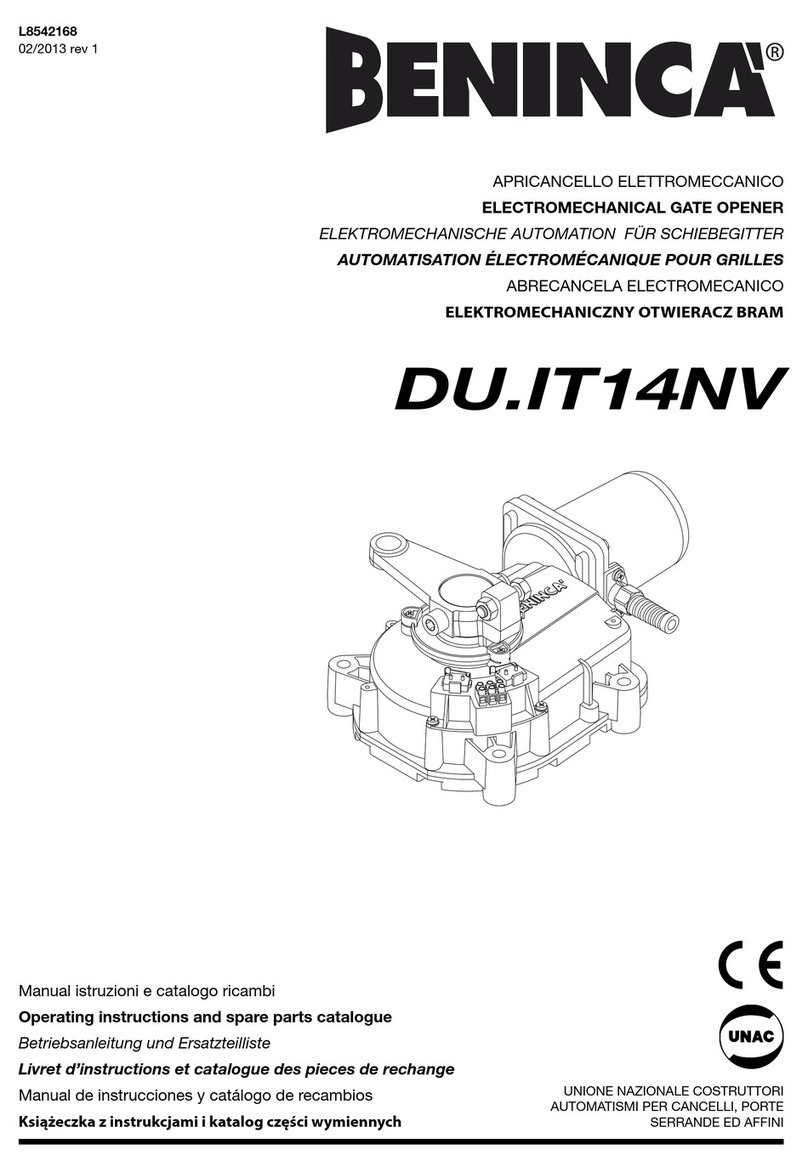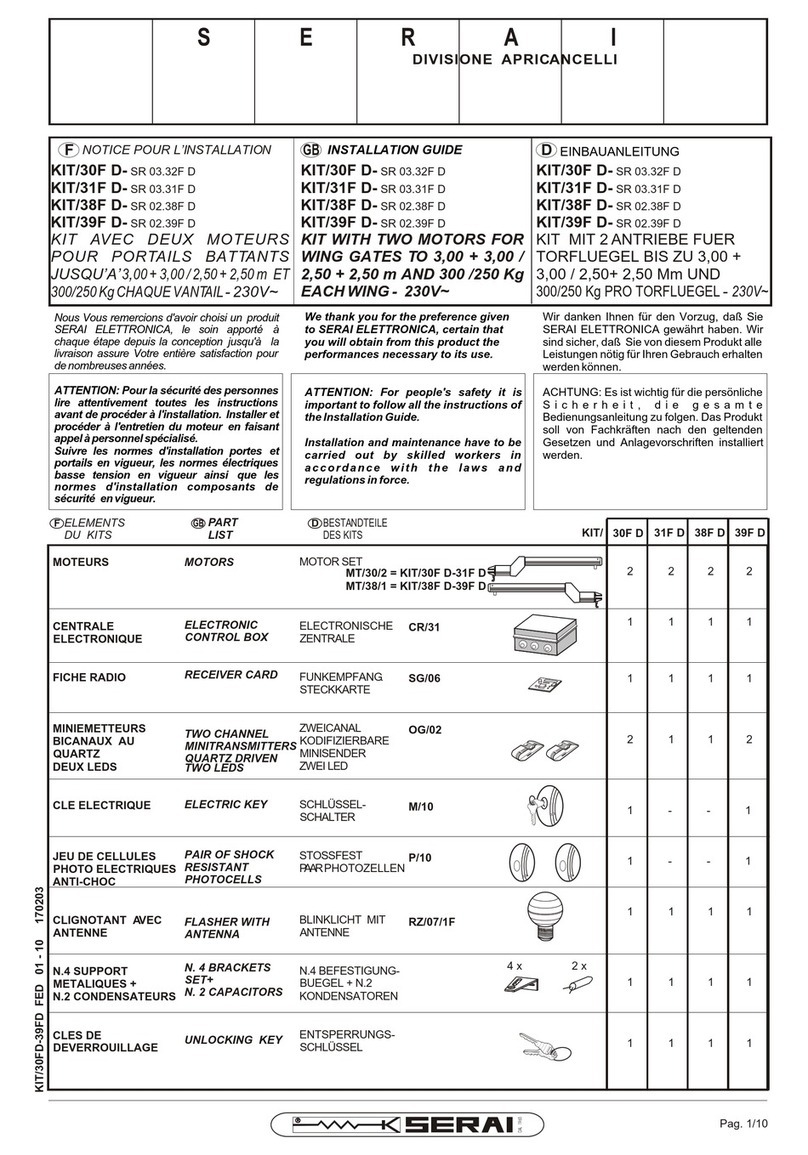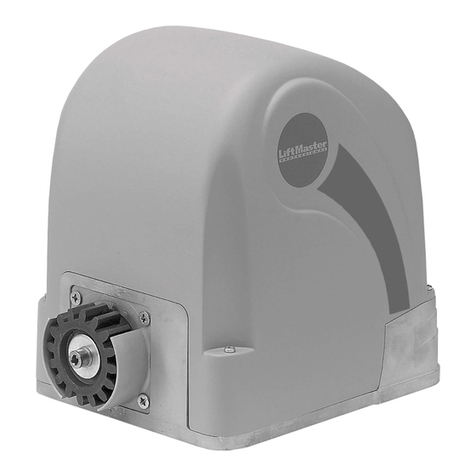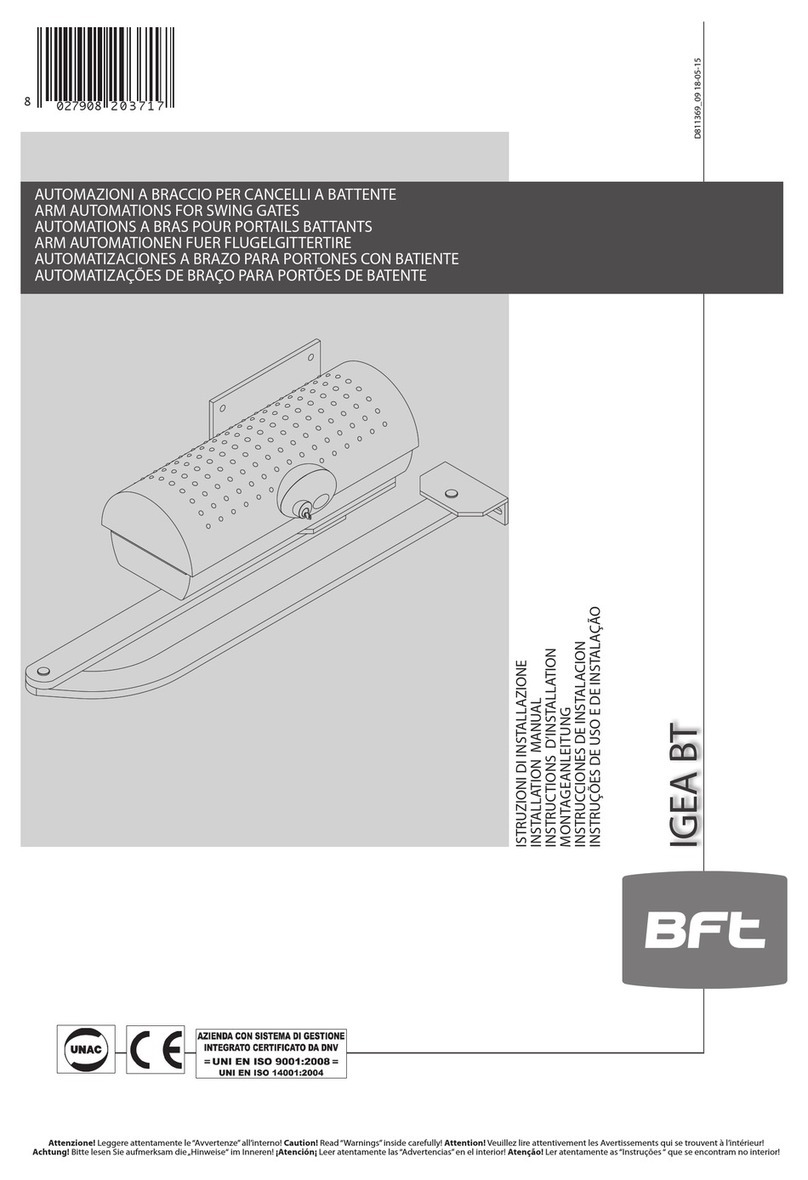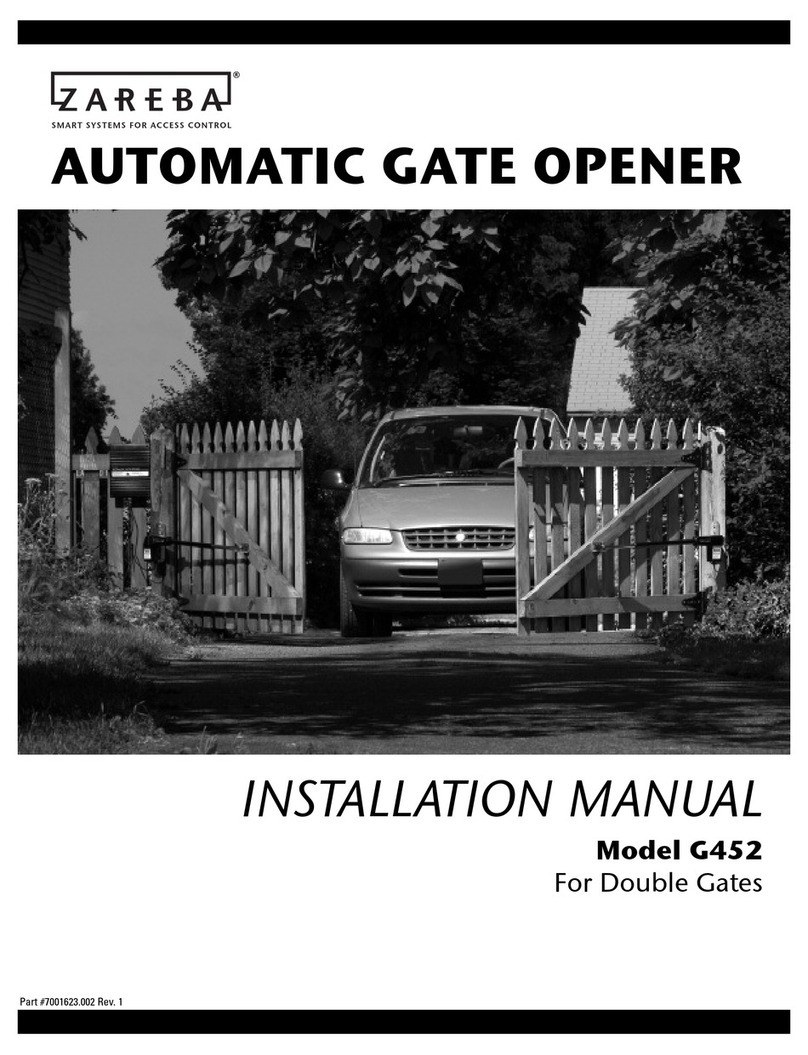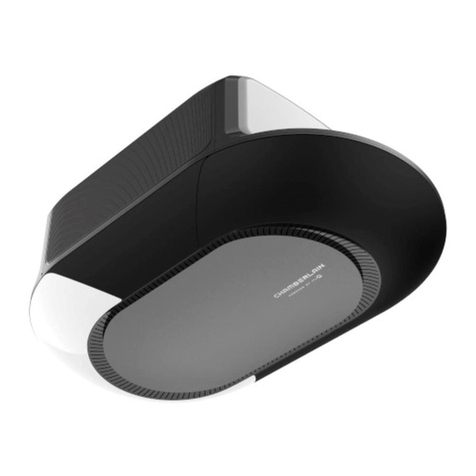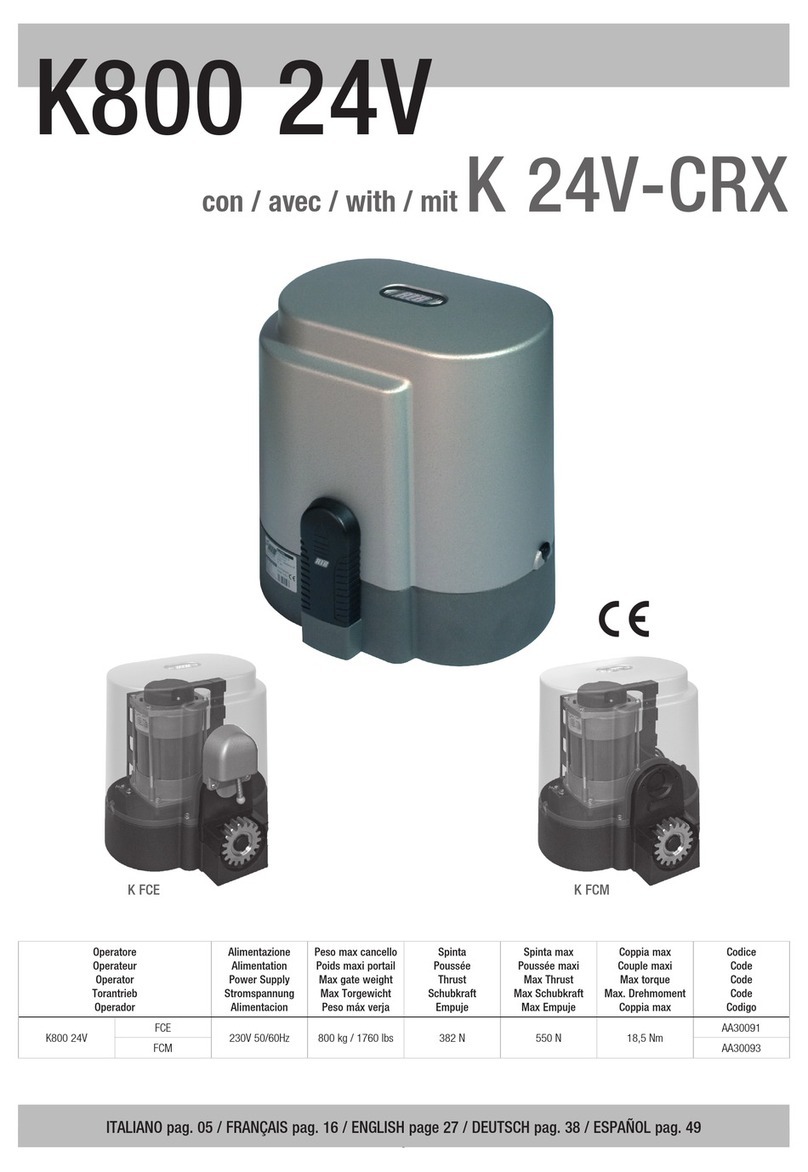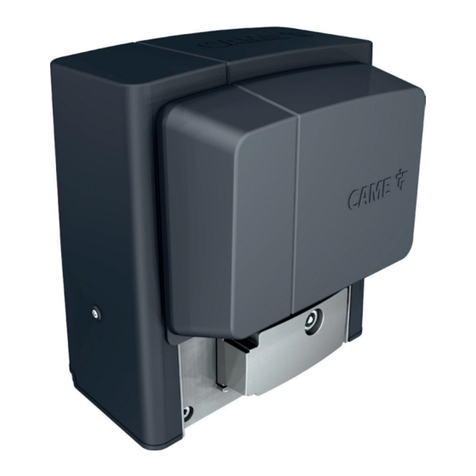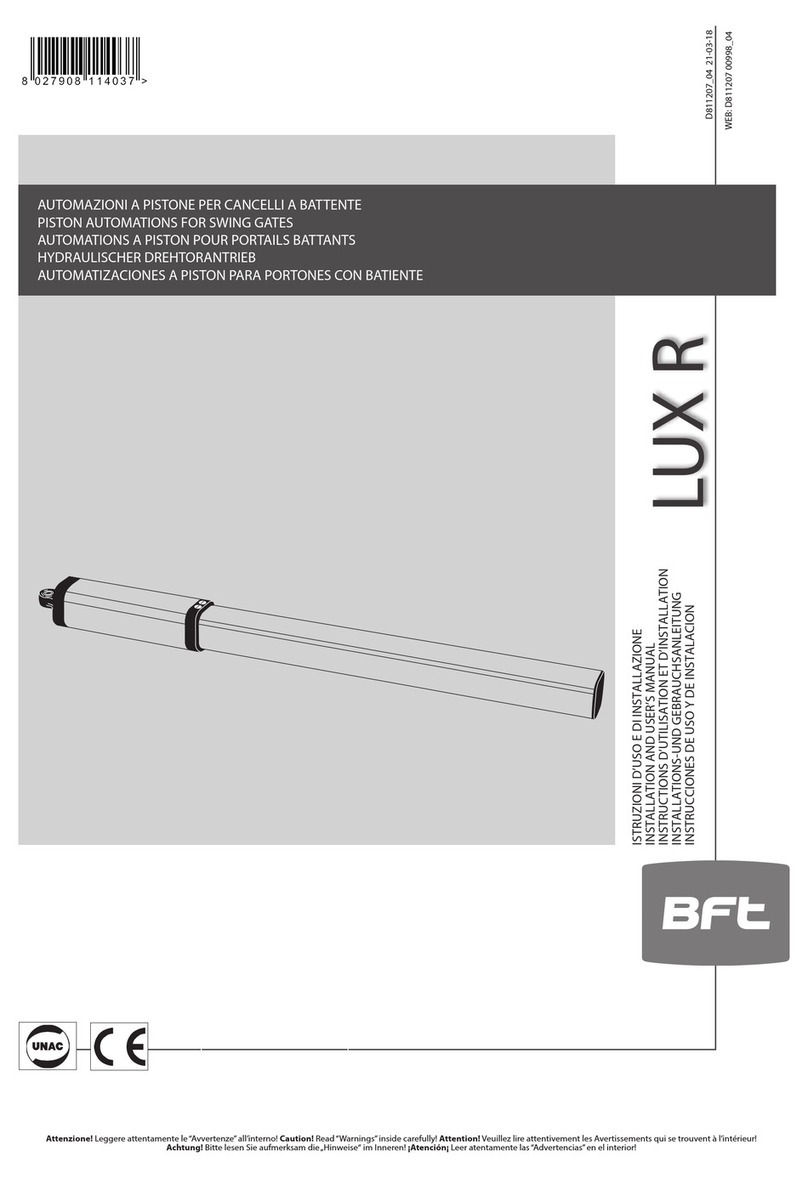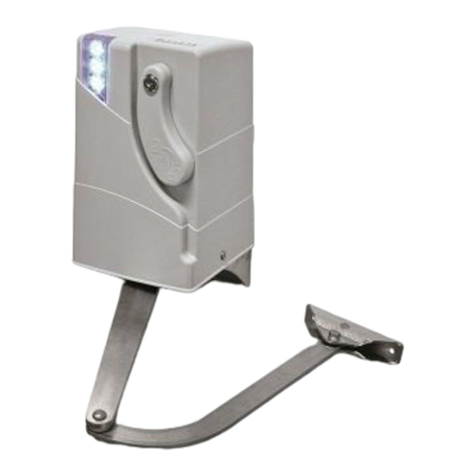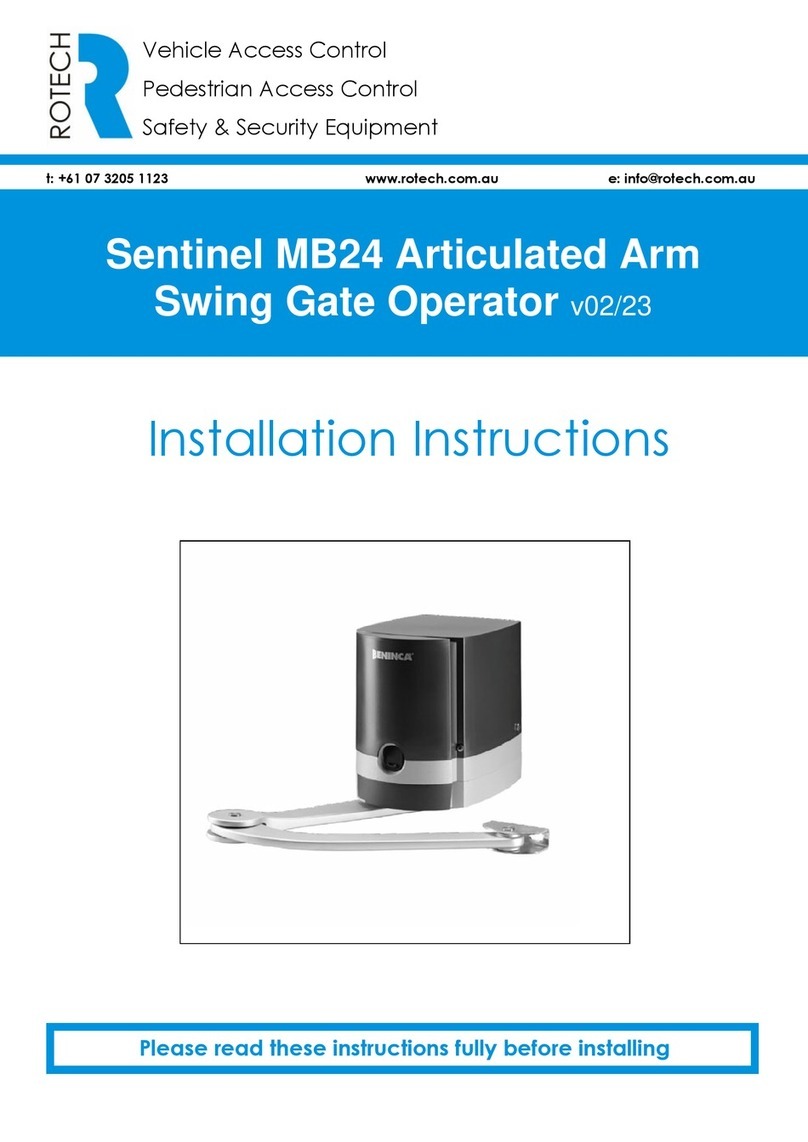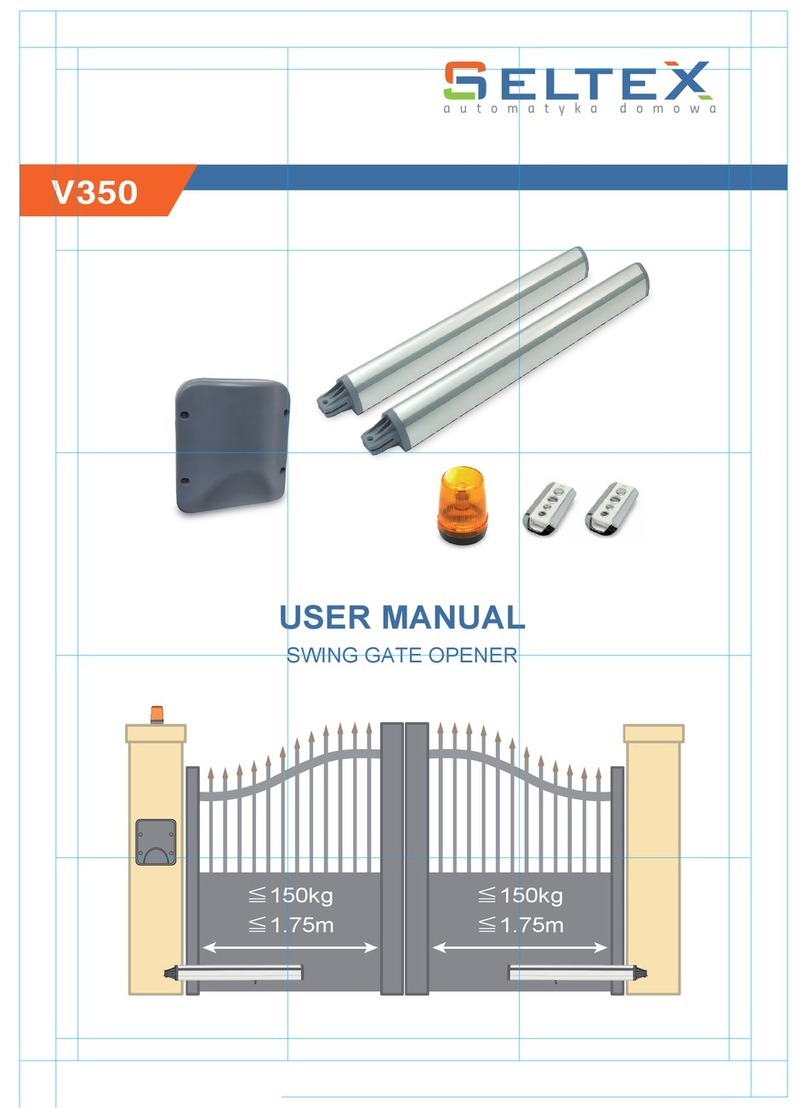Viking G-5 User manual

G-5
vehicular
gate operator
installation instructions and
safety information
CLASS I, CLASS II, CLASS III and CLASS IV
LISTED 18TC
UL 325
UL 991
Viking Access Systems
T 800.908.0884 • F 949.753.1640
631 Wald - Irvine, CA 92618
vikingaccess.com
revision B1 april 2007

TECHNICAL SUPPORT 1 800 908 0884
i
PARTS DIAGRAMPARTS DIAGRAM
2
5
15
3
1
4
12
10
10
8
9
11
14
6
7
13
16
32
Item Description
Part No.
1 Unit, Motor/Lead Screw VAG5
2 Cover, Lead Screw VAG5CLS
3 End Cap, Lead Screw Cover VAG5ECC
4Cover, Terminal 21990
5 Door, Access 6LUXS
6 Carrier, Lead Screw, with hardware VAG5CGH
7 Mounting Bracket, Front 21931
8 Bar, Limit Switch VAG5LB
9 Limit Switch (2) VAG5LS
10
Mounting Hardware, Back VAG5MHB
11 Mounting Bracket, Back VAG5MBB
12 Backing Plate, Bar Mount (2) 2T365
13 Key, Release VAG5KR
14 Holder, Cable VAG5CH
15 Dust Brush (2) VAG5DB1
16 Thumbscrew, Terminal Block Cover VAG5TSTC
17 ECU Box (Standard/Industrial) ECUB / ECUIB
18 Control Board
(Single/Master-Slave)
DUPCB10 / DUMSCB10
19 Toroid Transformer, 10 awg DUTO10
20 EMI Board DUEMI10
21 Battery (2) DUBA10
22 Battery Fuse Holder VABFH
23 Motor Harness
ECUMTHRN
24 Power Harness DUPHC
25 Alarm DUAL10
26 ECU Access Key ECUKEY
27 ECU Key Cylinder ECUKEYC
28 Reset Switch ECURW
29 Fuse Kit DUFSK10
30 Radio Antenna Kit VARAK
31Strain Relief
DH3/4NMCC
32 Warning Placard DUWPA
Overall Dimensions
Weight 40 lb.
WARNING - For Installation
By Qualified Personnel Only.
41"
19.70"
Max. Stroke
4.00"
4.75"
27
28
26
29
22
30
23
31
24
20
2119
18
17
25

TECHNICAL SUPPORT 1 800 908 0884 1
TABLE OF CONTENTSTABLE OF CONTENTS
Parts Diagram/Parts List . . . . . . . . . . . . . . . . . . . . . . . . . . . . . . . . . . . . . . . . . . .i
Important Safety Information
Important Safety Instructions . . . . . . . . . . . . . . . . . . . . . . . . . . . . . . . . . . . . . .2
Important Installation Instructions . . . . . . . . . . . . . . . . . . . . . . . . . . . . . . . . .2-3
Maintenance/General Safety Precautions . . . . . . . . . . . . . . . . . . . . . . . . . . . . . .4
Terminology . . . . . . . . . . . . . . . . . . . . . . . . . . . . . . . . . . . . . . . . . . . . . . . . . .5
Photo Beam (non-contact sensor) Installation . . . . . . . . . . . . . . . . . . . . . . . . . .6
Edge Sensor (contact sensor) Installation . . . . . . . . . . . . . . . . . . . . . . . . . . . . . .7
Manual Release . . . . . . . . . . . . . . . . . . . . . . . . . . . . . . . . . . . . . . . . . . . . . . . .7
Audible Alarm Reset Switch Installation . . . . . . . . . . . . . . . . . . . . . . . . . . . . . .8
Warning Placard Installation . . . . . . . . . . . . . . . . . . . . . . . . . . . . . . . . . . . . . .8
Important Installation Information . . . . . . . . . . . . . . . . . . . . . . . . . . . . . . . . . .9
Specifications . . . . . . . . . . . . . . . . . . . . . . . . . . . . . . . . . . . . . . . . . . . . . . . . .9
Plan of Installation – Open Inside . . . . . . . . . . . . . . . . . . . . . . . . . . . . . . . . . . .10
Plan of Installation – Open Outside . . . . . . . . . . . . . . . . . . . . . . . . . . . . . . . . . .11
Gate Operator Installation
Step 1 through 5 – Operator Installation . . . . . . . . . . . . . . . . . . . . . . . . . . . .12-13
Step 6 through 8 – Limit Switch Setup . . . . . . . . . . . . . . . . . . . . . . . . . . . . . . .14
Opening/Closing Setup . . . . . . . . . . . . . . . . . . . . . . . . . . . . . . . . . . . . . . . . . .15
Reference Wiring Diagram; Limit Switch Connections . . . . . . . . . . . . . . . . . . . .15
Control Box Installation . . . . . . . . . . . . . . . . . . . . . . . . . . . . . . . . . . . . . . . . . . .16
Electrical Installation
Electrical Installation (120/220 VAC) . . . . . . . . . . . . . . . . . . . . . . . . . . . . . . . .17
Single Unit Connections . . . . . . . . . . . . . . . . . . . . . . . . . . . . . . . . . . . . . . . . .18
Master/Slave Connections . . . . . . . . . . . . . . . . . . . . . . . . . . . . . . . . . . . . . . . .19
Vehicular Loop Detector Installation
Loop Layout Diagrams . . . . . . . . . . . . . . . . . . . . . . . . . . . . . . . . . . . . . . . . . .20
Installation Guidelines . . . . . . . . . . . . . . . . . . . . . . . . . . . . . . . . . . . . . . . . . . .21
Accessory Connections
Open Commands; Safety Connections . . . . . . . . . . . . . . . . . . . . . . . . . . . . . . . .22
Radio Receiver . . . . . . . . . . . . . . . . . . . . . . . . . . . . . . . . . . . . . . . . . . . . . . . .23
Viking Electromagnetic Lock . . . . . . . . . . . . . . . . . . . . . . . . . . . . . . . . . . . . . .24
Magnetic Lock; Solenoid; Guard Station . . . . . . . . . . . . . . . . . . . . . . . . . . . . . .25
Special Features
Intelligent Obstruction Sensor (Primary Entrapment Protection) . . . . . . . . . . . . .26
Fail Safe/Fail Secure Operation; Hold Open Timer . . . . . . . . . . . . . . . . . . . . . . .27
Gate Overlap Setting . . . . . . . . . . . . . . . . . . . . . . . . . . . . . . . . . . . . . . . . . . . .28
Solar Panel Installation . . . . . . . . . . . . . . . . . . . . . . . . . . . . . . . . . . . . . . . . . . .29
Viking Hinge . . . . . . . . . . . . . . . . . . . . . . . . . . . . . . . . . . . . . . . . . . . . . . . . . . .30
Troubleshooting . . . . . . . . . . . . . . . . . . . . . . . . . . . . . . . . . . . . . . . . . . . . . . . .31-33

TECHNICAL SUPPORT 1 800 908 0884
2
WARNING - Not following these instructions may cause severe injury or death to persons.
IMPORTANT SAFETY INFORMATIONIMPORTANT SAFETY INFORMATION
IMPORTANT SAFETY INSTRUCTIONS
WARNING – To reduce the risk of severe injury or death:
1. READ AND FOLLOW ALL INSTRUCTIONS.
2. Never let children operate or play with gate controls. Keep the remote control away from children.
3. Always keep people and objects away from the gate. NO ONE SHOULD CROSS THE PATH OF
THE MOVING GATE.
4. Test the gate operator monthly. The gate MUST reverse on contact with a rigid object or when
an object activates the non-contact sensors. After adjusting the force or the limit of travel,
retest the gate operator. Failure to adjust and retest the gate operator properly can increase the
risk of injury or death.
5. Use the manual release only when the gate is not moving.
6. KEEP GATES PROPERLY MAINTAINED. Read the owner’s manual. Have a qualified service per-
son make repairs to gate hardware.
7. The entrance is for vehicles only. Pedestrians must use separate entrance.
8. Every gate operator installation M
MU
US
ST
Thave secondary protection devices
against entrapment, such as edge sensors and photo beams more in particularly
in places where the risk of entrapment is more likely to occur.
9. SAVE THESE INSTRUCTIONS.
IMPORTANT INSTALLATION INSTRUCTIONS
1. Install the gate operator only when:
a) The operator is appropriate for the construction of the gate and the usage Class of the gate
(refer to page 5),
b) All openings of a horizontal slide gate are guarded or screened from the bottom of the gate
to a minimum of 4 feet (1.22 m) above the ground to prevent a 2-1/4 inch (57.2 mm)
diameter sphere from passing through the openings anywhere in the gate, and in that
portion of the adjacent fence that the gate covers in the open position,
c) ALL EXPOSED PINCH POINTS ARE ELIMINATED OR GUARDED, AND
d) GUARDING IS SUPPLIED FOR EXPOSED ROLLERS.
2. The operator is intended for installation only on gates used for vehicles. Pedestrians must be
supplied with a separate access opening. The pedestrian access opening shall be designed to
promote pedestrian usage. Locate the gate such that persons will not come in contact with the
vehicular gate during the entire path of travel of the vehicular gate.
3. The gate must be installed in a location so that enough clearance is supplied between the gate
and adjacent structures when opening and closing to reduce the risk of entrapment. Swinging
gates shall not open into public access areas.
4. The gate must be properly installed and work freely in both directions prior to the installation
of the gate operator. Do not over-tighten the operator clutch or pressure
relief valve to compensate for a damaged gate.
5. The gate operator controls must be placed so that the user has full view
of the gate area when the gate is moving AND AWAY FROM THE GATE
PATH PERIMETER,

TECHNICAL SUPPORT 1 800 908 0884 3
WARNING - Not following these instructions may cause severe injury or death to persons.
IMPORTANT SAFETY INFORMATIONIMPORTANT SAFETY INFORMATION
6. Controls intended for user activation must be located at least six feet (6’) away from any mov-
ing part of the gate and where the user is prevented from reaching over, under, around or
through the gate to operate the controls. Outdoor or easily accessible controls shall have a secu-
rity feature to prevent unauthorized use.
7. The Stop and/or Reset button must be located in the line-of-sight of the gate. Activation of the
reset control shall not cause the operator to start.
8. All warning signs and placards must be installed where visible in the area of the gate. A minimum
of two placards shall be installed. A placard is to be installed in the area of each side of the
gate and be visible to persons located on the side of the gate on which the placard is installed.
9. For gate operators utilizing a non-contact sensor (Photo beam or like) in
accordance with section 31.1.1 of the UL325 standard:
a) See instructions on the placement of non-contact sensors for each Type of
application (refer to page 6),
b) Care shall be exercised to reduce the risk of nuisance tripping, such as when
a vehicle, trips the sensor while the gate is still moving, and
c) One or more non-contact sensors shall be located where the risk of entrapment
or obstruction exists, such as the perimeter reachable by a moving gate or
barrier (refer to page 6).
d) Use only Omron E3K-R10K4 photoelectric eye to comply with UL325
10.
For a gate operator utilizing a contact sensor (Edge sensor or like) in
accordance with section 31.1.1 of the UL325 standard:
a) One or more contact sensors shall be located where the risk of entrapment or
obstruction exists, such as at the leading edge, trailing edge, and post mounted
both inside and outside of a vehicular horizontal slide gate (refer to page 7).
b) One or more contact sensors shall be located at the bottom edge of a vehicular
vertical lift gate.
c) One or more contact sensors shall be located at the pinch point of a vehicular
vertical pivot gate.
d) A hardwired contact sensor shall be located and its wiring arranged so that the
communication between the sensor and the gate operator is not subjected to
mechanical damage.
e) A wireless contact sensor such as one that transmits radio frequency (RF)
signals to the gate operator for entrapment protection functions shall be
located where the transmission of the signals are not obstructed or impeded
by building structures, natural landscaping or similar obstruction. A wireless
contact sensor shall function under the intended end-use conditions.
f) One or more contact sensors shall be located on the inside and outside leading
edge of a swing gate. Additionally, if the bottom edge of a swing gate is greater
than 6 inches (152 mm) above the ground at any point in its arc of travel, one
or more contact sensors shall be located on the bottom edge (refer to page 7).
g) One or more contact sensors shall be located at the bottom
edge of a vertical barrier (arm).
h) Use only Miller Edge Model MGR20 or MGS20 edge sensor
to comply with UL325
IMPORTANT INSTALLATION INSTRUCTIONS Continued

TECHNICAL SUPPORT 1 800 908 0884
4
WARNING - Not following these instructions may cause severe injury or death to persons.
IMPORTANT SAFETY INFORMATIONIMPORTANT SAFETY INFORMATION
GENERAL SAFETY PRECAUTIONS
The following precautions are an integral and essential part of the product and must be supplied to the user.
Read them carefully as they contain important indications for the safe installation, use and maintenance.
• These instruction must be kept and forwarded to all possible future users of the system.
• This product must be used only for that which it has been expressly designed.
• Any other use is to be considered improper and therefore dangerous.
• The manufacturer cannot be held responsible for possible damage caused by improper, erroneous or
unreasonable use.
• Avoid operating in the proximity of the hinges or moving mechanical parts.
• Do not enter the path of the moving gate while in motion.
• Do not obstruct the motion of the gate as this may cause a situation of danger.
• Do not allow children to play or stay within the the path of the moving gate.
• Keep remote control or any other control devices out of the reach of children, in order to avoid possible
involuntary activation of the gate operator.
• In case of break down or malfunctioning of the product, disconnect from the main power source. Do not
attempt to repair or intervene directly, contact only qualified personnel for repair.
• Failure to comply with the above may create a situation of danger.
•All cleaning, maintenance or repair work must be carried out by qualified personnel.
•In order to guarantee that the system works efficiently and correctly it is important to have the manufacturer’s
instructions on maintenance of the gate and operator carried out by qualified personnel.
• In particular, regular checks are recommended in order to verify that the safety devices are operating correctly.
All installation, maintenance and repair work must be documented and made available to the user.
Installer:
_____________________________________________________ ____________
Signature Date
Contact: _________________________________________________________
_________________________________________________________
MAINTENANCE
Remove the Power Harness from the Control Board (refer to page 17)
• Clean and lubricate the turning pins and gate hinges using the recommended lubricant.
• Clean and lubricate the lead screw using silicon grease.
• Check that all mounting hardware of the gate operator is properly tighten.
• Ensure that the gate moves freely.
• Check for corroded parts and replace if necessary.
• Check the battery for the following:
Battery connections must be free of corrosion.
Battery voltage must be 26 VDC (fully charged battery).
Reconnect the Power Harness for the Control Board (refer to page 17)
• Check and confirm the proper operation of all safety devices (photoelectric eye, edge sensors or like).
• Check and confirm the operation of all installed accessories.
• Check and confirm the operation of all special features such as the Intelligent Obstruction Sensor, Hold
Open Timer (refer to page 20 to 27)
• Check and confirm the operation of the manual release (refer to page 7)
• Verify battery backup functionally by turning off the power source (120 VAC and 220 VAC).
DO NOT FORGET TO TURN ON THE POWER SOURCE AFTER VERIFICATION.

TECHNICAL SUPPORT 1 800 908 0884 55
UL325 Gate Operator Classification
TERMINOLOGYTERMINOLOGY
GLOSSARY
RESIDENTIAL VEHICULAR GATE OPERATOR
CLASS I – A vehicular gate operator (or system) intended for use
in a home of one-to four single family dwelling, or a garage or
parking area associated therewith.
COMMERCIAL/GENERAL ACCESS VEHICULAR GATE OPERATOR
CLASS II – A vehicular gate operator (or system) intended for use
in a commercial location or building such as a multi-family hous-
ing unit (five or more single family units), hotel, garages, retail
store, or other building servicing the general public.
INDUSTRIAL/LIMITED ACCESS VEHICULAR GATE OPERATOR
CLASS III – A vehicular gate operator (or system) intended for
use in an industrial location or building such as a factory or
loading dock area or other locations not intended to service the
general public.
RESTRICTED ACCESS VEHICULAR GATE OPERATOR
CLASS IV – A vehicular gate operator (or system) intended for
use in a guarded industrial location or building such as an air-
port security area or other restricted access locations not servic-
ing the general public, in which unauthorized access is prevented
via supervision by security personnel.
Install the gate operator only when:
The operator is appropriate for the construction of the gate and the Usage
Class of the gate.

TECHNICAL SUPPORT 1 800 908 0884
6
WARNING - Not following these instructions may cause severe injury or death to persons.
IMPORTANT SAFETY INFORMATIONIMPORTANT SAFETY INFORMATION
Photo Beam (non-contact sensor) Installation
Secondary Entrapment Protection
Gate in Open Position
Photo Beam Unit Reflector
Potential Entrapment
Area (Shaded)
Radio Station
Mag.
Lock
Mag. Lock
Safety ConnectorOpen CommandsGuard StationMaster/Slave
Brake
UL
Siren
Radio
Rec.
UL
Sensor
OPEN RIGHT
24V BAT 24VAC
OPEN LEFT
Safety
Loop
Center
Loop
Obstruction
Sensor Charger
Power
Low Battery
Motor Sensor
Hold Open
Timer
Stop
Overlap Delay
Close Open
Obstruction
Sensor
min. MAX
Overlap
Delay
1.5
0
3
Radio StationLoop ConnectorOpen CommandsGuard StationMaster/Slave
GND
Close
Stop
Open
GND
Close
Stop
Open
Gnd
Fire
Gnd
Strike
Gnd
Exit
Gnd
Center
Gnd
Reopen
Gnd
UL
Gnd
+28v
Gnd
Radio
Gnd
+28v
+28v
Mag.
Lock
Fail
Safe/Secure
MAG. LOCK
N.C.
COM
N.O.
Charger
Power
Low Battery
Motor Sensor
Hold Open
Timer
Stop
Close
Open
30
60
Off 1
Radio
Rec.
UL
Sens
Safety
Loop
Center
Loop
Brake
Siren
11
(C1)(C1)
33
(NC1)(NC1) 24VDC24VDC
1
(C1)
3
(NC1) 24VDC
Turn Switch
to 'Light On'
Position
24 VDC Power Connections
24 VDC Power Connections
Omron
Model
E3K-R10
Shown
Connection '3' (NC1)
Connection '1' (C1)
Photo beams or like must be installed to reduce the risk of entrapment.
Use only Omron E3K-R10K4 photoelectric eye to comply with UL325
Make the electrical connections of the photoelectric sensor as described here in this page.
Care shall be exercised to reduce the risk of nuisance tripping, such as when a
vehicle, trips the sensor while the gate is still moving, and
One or more non-contact sensors shall be located where the risk of entrapmentor
obstruction exists, such as the perimeter reachable by a moving gate or barrier.
NOTE - This type of installation DOES NOT reverse the gate all the way back to its limits when the photo-beam
is obstructed. This installation is only to protect against entrapment and to comply with UL325.
One or more non-contact sensors shall be located where the risk of entrapment or
obstruction exists, such as the perimeter reachable by a moving gate or barrier.
Consult the installation manual for the UL325 device (photo
beam or like) for detail information about the usage,
installation and maintenance

TECHNICAL SUPPORT 1 800 908 0884 7
Radio Station
Mag.
Lock
Mag. Lock
Safety ConnectorOpen CommandsGuard StationMaster/Slave
Brake
UL
Siren
Radio
Rec.
UL
Sensor
OPEN RIGHT
24V BAT 24VAC
OPEN LEFT
Safety
Loop
Center
Loop
Obstruction
Sensor Charger
Power
Low Battery
Motor Sensor
Hold Open
Timer
Stop
Overlap Delay
Close Open
Obstruction
Sensor
min. MAX
Overlap
Delay
1.5
0
3
Radio StationLoop ConnectorOpen CommandsGuard StationMaster/Slave
GND
Close
Stop
Open
GND
Close
Stop
Open
Gnd
Fire
Gnd
Strike
Gnd
Exit
Gnd
Center
Gnd
Reopen
Gnd
UL
Gnd
+28v
Gnd
Radio
Gnd
+28v
+28v
Mag.
Lock
Fail
Safe/Secure
MAG. LOCK
N.C.
COM
N.O.
Charger
Power
Low Battery
Motor Sensor
Hold Open
Timer
Stop
Close
Open
30
60
Off 1
Radio
Rec.
UL
Sens
Safety
Loop
Center
Loop
Brake
Siren
WARNING - Not following these instructions may cause severe injury or death to persons.
IMPORTANT SAFETY INFORMATIONIMPORTANT SAFETY INFORMATION
Edge Sensor (contact sensor) Installation
Secondary Entrapment Protection
Edge sensor or like must be installed to reduce the risk of entrapment.
Use only Miller Edge 3-sided activation type MGR20 or MDS20 to comply with UL325
One or more contact sensors shall be located on the inside and outside leading edge
of a swing gate. Additionally, if the bottom edge of a swing gate is greater than 6
inches (152 mm) above the ground at any point in its arc of travel, one or more
contact sensors shall be located on the bottom edge.
1. A hardwired contact sensor shall be located and its wiring arranged so that the
communication between the sensor and the gate operator is not subjected to
mechanical damage.
2. A wireless contact sensor such as one that transmits radio frequency (RF) signals
to the gate operator for entrapment protection functions shall be located where
the transmission of the signals are not obstructed or impeded by building
structures, natural landscaping or similar obstruction. A wireless contact sensor
shall function under the intended end-use conditions.
Manual Release
When manual operation is required:
Insert the key and rotate clockwise. This will
allow the gate to be moved manually.
To reengage the gate operator, turn the key
counter-clockwise
Attention: Lock and release operations MUST
be performed with motor NOT RUNNING.
3-Sided Edge Sensor
3-Sided Edge Sensor
Unlock
Lock

TECHNICAL SUPPORT 1 800 908 0884
8
Audible Alarm Reset Switch Installation
Manual Reset for the Audible Alarm
UL325 standard requires an audible alarm to go off after two consecutive events
detected by the primary entrapment protection of the gate operator (obstruction sensor).
The audible alarm will continue to sound for 5 minutes or until a stop command
gets actuated.
The Stop command can be actuated in two different forms
1. Using the Built in Stop switch on the Control Box or
2. Using an External Stop button within the sight of the gate, away from moving
parts of the gate and out of reach of children.
3. Controls intended for user activation must be located at least six feet (6’) away
from any moving part of the gate and where the user is prevented from reaching
over, under, around or through the gate to operate the controls. Outdoor or easily
accessible controls shall have a security feature to prevent unauthorized use.
4. The Stop and/or Reset button must be located in the line-of-sight of the gate.
Activation of the reset control shall not cause the operator to start.
WARNING - Not following these instructions may cause severe injury or death to persons.
IMPORTANT SAFETY INFORMATIONIMPORTANT SAFETY INFORMATION
Warning Placard Installation
Manual Stop
Button
5'
Minimum
STOP
All Warning Signs and Placards must be installed where visible in the area
of the gate. A minimum of two placards shall be installed. A placard is
to be installed in the area of each side of the gate and be visible.
Radio Station
Mag.
Lock
Mag. Lock
Safety ConnectorOpen CommandsGuard StationMaster/Slave
Brake
UL
Siren
Radio
Rec.
UL
Sensor
OPEN RIGHT
24V BAT 24VAC
OPEN LEFT
Safety
Loop
Center
Loop
Obstruction
Sensor Charger
Power
Low Battery
Motor Sensor
Hold Open
Timer
Stop
Overlap Delay
Close Open
Obstruction
Sensor
min. MAX
Overlap
Delay
1.5
0
3
Radio StationLoop ConnectorOpen CommandsGuard StationMaster/Slave
GND
Close
Stop
Open
GND
Close
Stop
Open
Gnd
Fire
Gnd
Strike
Gnd
Exit
Gnd
Center
Gnd
Reopen
Gnd
UL
Gnd
+28v
Gnd
Radio
Gnd
+28v
+28v
Mag.
Lock
Fail
Safe/Secure
MAG. LOCK
N.C.
COM
N.O.
Charger
Power
Low Battery
Motor Sensor
Hold Open
Timer
Stop
Close
Open
30
60
Off 1
Radio
Rec.
UL
Sens
Safety
Loop
Center
Loop
Brake
Siren
COM
N.O.
STOP

TECHNICAL SUPPORT 1 800 908 0884 9
CAUTION -
FOR USE WITH GATES OF A MAXIMUM OF 16 FT IN LENGTH AND 700 LBS. IN WEIGHT.
WARNING - TO REDUCE THE RISK OF SEVERE INJURY OR DEATH TO PERSONS:
IMPORTANT INSTALLATION INFORMATIONIMPORTANT INSTALLATION INFORMATION
Specifications
This is NOT a pedestrian gate operator
16’ maximum gate length
700 pounds maximum gate weight
Do NOT Install the gate operator to lift gates
Maximum Gate Length: 16 feet
Maximum Gate Weight: 700 lbs.
Maximum Aperture Angle: 120 deg.
Power Requirements: 120 VAC Single Phase at 2 Amps
Or
220 VAC Single Phase at 1 Amp
Operating Temperature: -20°C (-4°F) to
70°C (158°F)
700 lb.
MAX.
16'-0"
CLOSE
STOP
OPEN
ControlControl
ButtonButtonss
Control
Buttons
Locate Control Buttons:
1. Within sight of the gate,
2. At a minimum height of 5 feet so
small children are not able to
reach it, and
3. Away from all moving parts of
the gate.

BC
Inside
Outside
Gate in Closed Position
D
90°/ 120°
A
E
Gate in Open Position
Note: Back Mounting Bracket
Must Be Cut to Obtain
Desired Dimension “A”
TECHNICAL SUPPORT 1 800 908 0884
10
PLAN OF INSTALLATION - OPEN INSIDEPLAN OF INSTALLATION - OPEN INSIDE
The gate must be installed in a location so that enough clearance is supplied
between the gate and adjacent structures when opening and closing to reduce the
risk of entrapment.
Swinging gates shall not open into public access areas.
Note: Varying from the dimensions shown
may severely affect the speed and
performance of the gate operator.
Figure A
Open Inside Plan of Installation
NORMAL INSTALLATION
Range AB C D E Opening Time
Option A 6.00 4.50 27 31.5 4.75 14 seconds
Option B 6.625 7.875 28 35.875 4.75 20 seconds

TECHNICAL SUPPORT 1 800 908 0884 11
The gate must be installed in a location so that enough clearance is supplied
between the gate and adjacent structures when opening and closing to reduce the
risk of entrapment.
Swinging gates shall not open into public access areas.
PLAN OF INSTALLATION – OPEN OUTSIDEPLAN OF INSTALLATION – OPEN OUTSIDE
Inside
Outside
Not aNot a
PublicPublic
Access AreaAccess Area
A: 7-7/8"
C:
28"
Custom Plate
Required
(Not Supplied)
90°/ 105°
B:
6-5/8"
E: 4-3/4"
Gate in Open Position
Gate in Closed Position
D:
35-7/8"
Figure B
Open Outside Plan of Installation
Note: Varying from the dimensions shown
may severely affect the speed and
performance of the gate operator.

TECHNICAL SUPPORT 1 800 908 0884
12 16
STEP 1
Cut the Front Mounting Bar (the offset bar)
so that:
The bolt center is 4-3/4” from the inside surface
of
the gate and 27” to 28” from the gate hinge.
Note: It is recommended to use a frame
member across the full width of the gate.
A backing plate is provided for gates of non-
ferrous construction. Tack weld the bar in place.
Refer to Figure A or B, page 10 or 11 for
proper configuration.
STEP 2
Cut and position the pivot bar according to
Figure A or B, page 10 or 11. Tack weld the
pivot bracket, ensuring that the two bars are
level as shown on the right.
Note: For an Open Outside gate, an additional
bracket will need to be fabricated to obtain the
proper configuration (see Figure B, page 11).
Level Line
See Figure A
(Page 10)
For Location
GATE OPERATOR INSTALLATIONGATE OPERATOR INSTALLATION
CAUTION - If Front Mounting Bar is not welded to a frame member that runs the
full length of the gate, the gate operator may damage the gate. Do not weld the
bar or backing plate to a few pickets.
Note: Depending on type of anchor used, it
may be required to enlarge the mounting
holes in the pivot bracket.

TECHNICAL SUPPORT 1 800 908 0884 1317
Step 3
Remove the Terminal Cover:
a) Open the plastic flap and
b) Remove the Thumbscrew.
STEP 4
Mount the operator. Perform the Manual
Release procedure as shown at the bottom of
page 7. The gate can now be moved
manually.
Ensure that the gate and gate operator moves
freely.
Once it is determined the operator will work
properly, remove the operator and complete
the welding process.
Check Operation
Through Entire
Range of
Movment
STEP 5
Remount the gate operator. Lubricate the
moving parts (the carrier bolt shaft on the
lead screw bar, the large and small washer)
and tighten the self-locking nut.
Level Bars
as shown
Lead Screw Carrier
Front Mounting Bar
Small Flat
Washer
Lock
Washer
GATE OPERATOR INSTALLATIONGATE OPERATOR INSTALLATION

TECHNICAL SUPPORT 1 800 908 0884
14 18
STEP 6
Remove the lead screw cover:
a) Remove the screw and
b) Slide out the cover.
Pull Cover
Forward and
Remove
STEP 7
Loosen the screws on the limit switch
holders and position the limit switches to
the desired position.
Move the gate manually and ensure that the
limit switch gets actuated at the desired
open and closed position. The limit switch
will click when engaged by the lead screw
carrier.
Retighten the screws on the limit switch
holders once the proper position has been
determined (DO NOT OVERTIGHTEN).
Adjust the
Limit Switches
Note: Leave cover off until after the installation
of the control box and the electrical
installation. Verify that the operator opens
and closes to the desired position under
power. Make any adjustments as necessary.
STEP 8
Replace the cover taking care to position the
shaft properly inside the endcap.
Limit Switch Setup
GATE OPERATOR INSTALLATIONGATE OPERATOR INSTALLATION

O
r
a
n
g
e
Y
e
l
l
o
w
B
l
u
e
B
l
a
c
k
B
r
o
w
n
R
e
d
To Limit
Switches To Motor
Wire Lead
From Control Box
TECHNICAL SUPPORT 1 800 908 0884 15
Note: Use this wiring
diagram as a guide to
connect the wires to the
motor unit.
The Limit Switches are wired as shown
Limit Switch Connections
COM
N.O.
N.C.
Yellow
Orange
COM
N.O.
N.C.
Brown
Red
Limit Switch Limit Switch
Connect the lead wires as shown
To have the gate operator slow down prior to reaching its limits use the following steps:
1. Setup the Limit Switches manually at the desired open and close position.
2. Allow the gate operator to run a full open and close cycle (from limit to limit)
without interruption.
Note: During the first full open and close cycle: The gate operator doesn’t slow
down prior to reaching its limits. During subsequent cycles: The gate operator will
slow down prior to reaching its limits.
3. Verify that the gate opens and closes to the desired position.
To change the open or close limit position(s) the following steps MUST BE taken:
A. Reset the gate operator by performing one of the following steps:
i. Disconnect the Motor/Limit Harness Connector
(see page 18 or 19) or
ii. Actuate both limits at the same time
B. Repeat steps 1,2 and 3.
Reference Wiring Diagram
Opening/Closing Setup:
GATE OPERATOR INSTALLATIONGATE OPERATOR INSTALLATION
Fast
Slow
Slow

TECHNICAL SUPPORT 1 800 908 0884 1516
CONTROL BOX INSTALLATIONCONTROL BOX INSTALLATION
WARNING - If the control box is not
mounted properly it may fall, causing
damage and/or injury. The Electronic
Control Unit (ECU) weight is
approximately 40 lbs. Be sure that the
substrate being mounted to and the
fasteners being used are appropriate to
support the weight of the control box.
2. Position the ECU Box in the desired place
and mark the mounting holes. Prepare the
holes to receive the anchors/fasteners.
15" Standard
17" Industrial
Depth:
6.5" Standard
6.5" Industrial
14" Standard
16" Industrial
1. Disconnect the Siren and Stop Button
Leads from the Control Board. Remove
the Control Board Mounting Plate. The
plate is held in the box by four screws.
3. Position the ECU Box and secure it to the
mounting surface using the Sealed
Washers provided (place the rubber side
of the washers against the inside of the
control box).
Mounting Surface
Control Box
Sealed Washer
(Supplied with Unit)
Mounting Fastener
(Customer Supplied)
Note: Depending on type of anchor used, it
may be necessary to enlarge the
mounting holes in the control box.

TECHNICAL SUPPORT 1 800 908 0884 17
The G-5 Gate Operator requires a single phase
AC line to operate and charge the batteries.
1. Turn off the main switch or breaker for
the power line being used.
2. Move the selector switch on the Incoming
Voltage Selector to the proper position
(115 for 110 to 120VAC, 230 for 200 to 240VAC).
3. Connect the incoming power wires to the
terminals as shown in the illustration.
4. Turn on the main switch or breaker once
the installation is ready for performance
check and adjustments.
5. To verify that there is AC power to the
system, check that the ‘Charger’ LED on the
Control Board is on.
ELECTRICAL INSTALLATIONELECTRICAL INSTALLATION
N
e
u
t
r
a
l
H
o
t
P
o
w
e
r
G
r
o
u
n
d
E
a
r
t
h
G
r
o
u
n
d
To
Transformer
EMI
Board
3A FUSE
Part # VAEMI
Tips for proper ground installation
A good ground in a gate operator
installation will minimize or prevent damage
to the operator cause by natural events such
as lightning strikes.
The following will provide a guideline for
proper grounding:
1. Use a ground rod to provide a ground
reference.
2. Consult your city code and be aware of
under-ground services in the site of the
gate operator to prevent inconveniences.
3. Use always a single bonding point for
grounding.
4. All ground wires must be as short and as
thick as possible.
5. Prevent unnecessary turns or loops in all
ground wires.
Ground Rod
Earth Ground
Caution – Do not connect the power harness to the board
until the installation is ready for verification.
Radio Station
Mag.
Lock
Mag. Lock
Safety ConnectorOpen CommandsGuard StationMaster/Slave
Brake
UL
Siren
Radio
Rec.
UL
Sensor
OPEN RIGHT
24V BAT 24VAC
OPEN LEFT
Safety
Loop
Center
Loop
Obstruction
Sensor Charger
Power
Low Battery
Motor Sensor
Hold Open
Timer
Stop
Overlap Delay
Close Open
Obstruction
Sensor
min. MAX
Overlap
Delay
1.5
0
3
Radio StationLoop ConnectorOpen CommandsGuard StationMaster/Slave
GND
Close
Stop
Open
GND
Close
Stop
Open
Gnd
Fire
Gnd
Strike
Gnd
Exit
Gnd
Center
Gnd
Reopen
Gnd
UL
Gnd
+28v
Gnd
Radio
Gnd
+28v
+28v
Mag.
Lock
Fail
Safe/Secure
MAG. LOCK
N.C.
COM
N.O.
Charger
Power
Low Battery
Motor Sensor
Hold Open
Timer
Stop
Close
Open
30
60
Off 1
Radio
Rec.
UL
Sens
Safety
Loop
Center
Loop
Brake
Siren
Power Harness
Auxiliary Power Connection.
See page 29 for further details.
Black
Red
Green
White

TECHNICAL SUPPORT 1 800 908 0884
18
Connect the wires from the motor unit to
the terminal block mounted next to the
control board. Match wire colors to the
terminal block.
Single Unit Connections
ELECTRICAL INSTALLATION – SINGLE UNITELECTRICAL INSTALLATION – SINGLE UNIT
Match
Colors
Connect the wire harness to the “OPEN RIGHT”
connector if the gate opens inside. Connect
the wire harness to the “OPEN LEFT”
connector if the gate opens outside.
Radio Station
Mag.
Lock
Mag. Lock
Safety ConnectorOpen CommandsGuard StationMaster/Slave
Brake
UL
Siren
Radio
Rec.
UL
Sensor
OPEN RIGHT
OPEN LEFT
Safety
Loop
Center
Loop
Obstruction
Sensor Charger
Power
Low Battery
Motor Sensor
Hold Open
Timer
Stop
Overlap Delay
Close Open
Obstruction
Sensor
min. MAX
Overlap Delay
1.5
03
Radio StationSafety ConnectorOpen CommandsGuard StationMaster/Slave
GND
Close
Stop
Open
GND
Close
Stop
Open
Gnd
Fire
Gnd
Strike
Gnd
Exit
Gnd
Center
Gnd
Safety
Gnd
UL
Gnd
+28v
Gnd
Radio
Gnd
+28v
+28v
Mag.
Lock
Mag. Lock
N.O.
COM
N.C.
Charger
Power
Low Battery
Motor Sensor
Hold Open
Timer
StopClose Open
Limit Limit
30sec
60sec off
1sec
Radio
Rec.
UL
Sensor
Safety
Loop
Center
Loop
Brake
UL
Siren
Radio Station
Mag.
Lock
Mag. Lock
Safety ConnectorOpen CommandsGuard StationMaster/Slave
Brake
UL
Siren
Radio
Rec.
UL
Sensor
OPEN RIGHT
OPEN LEFT
Safety
Loop
Center
Loop
Obstruction
Sensor Charger
Power
Low Battery
Motor Sensor
Hold Open
Timer
Stop
Overlap Delay
Close Open
Obstruction
Sensor
min. MAX
Overlap Delay
1.5
03
Radio StationSafety ConnectorOpen CommandsGuard StationMaster/Slave
GND
Close
Stop
Open
GND
Close
Stop
Open
Gnd
Fire
Gnd
Strike
Gnd
Exit
Gnd
Center
Gnd
Safety
Gnd
UL
Gnd
+28v
Gnd
Radio
Gnd
+28v
+28v
Mag.
Lock
Mag. Lock
N.O.
COM
N.C.
Charger
Power
Low Battery
Motor Sensor
Hold Open
Timer
StopClose Open
Limit Limit
30sec
60sec off
1sec
Radio
Rec.
UL
Sensor
Safety
Loop
Center
Loop
Brake
UL
Siren
Gate opens inside
Gate opens outside
Open
Open
Gate opens outside
Gate opens inside
Other manuals for G-5
1
Table of contents
Other Viking Gate Opener manuals
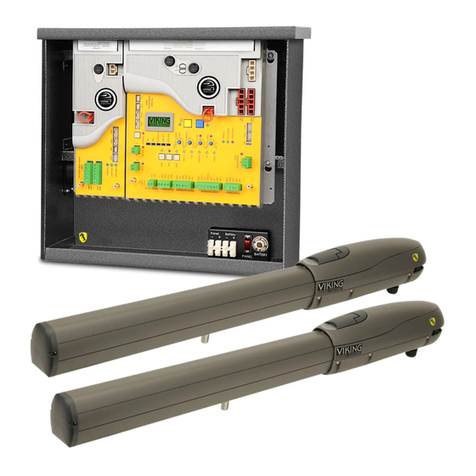
Viking
Viking G-5S User manual
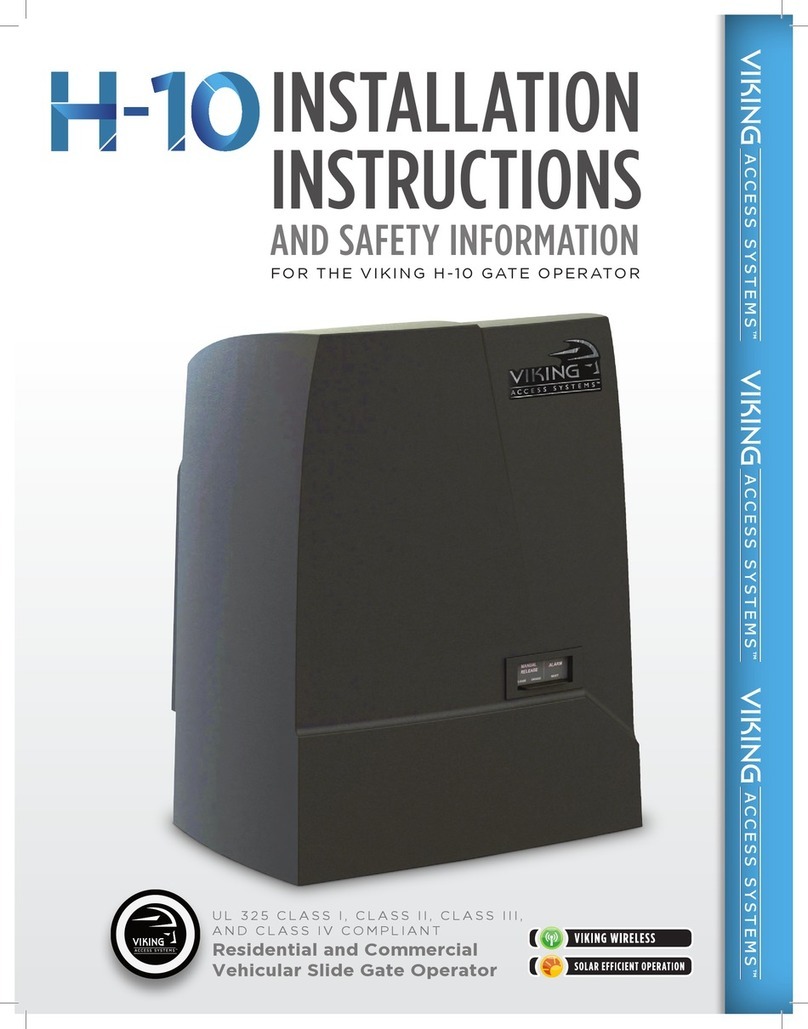
Viking
Viking H-10 Original instructions
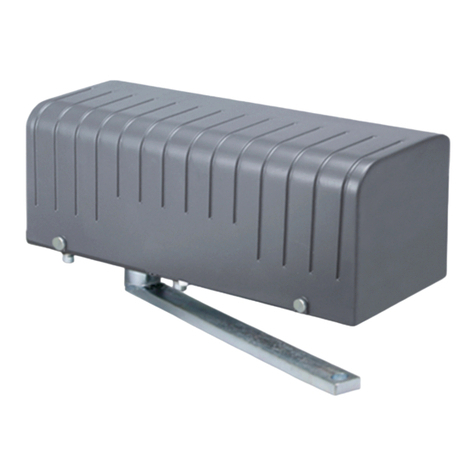
Viking
Viking X-9 Original instructions

Viking
Viking T-21 Original instructions
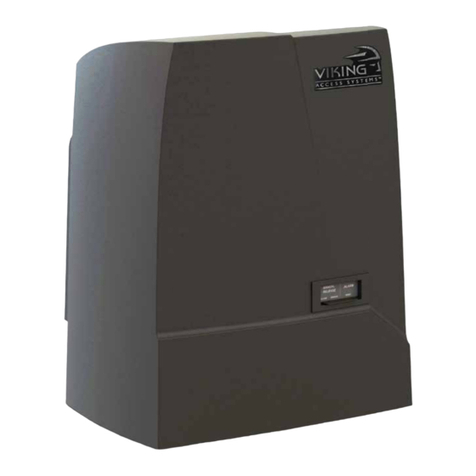
Viking
Viking Designer I User manual
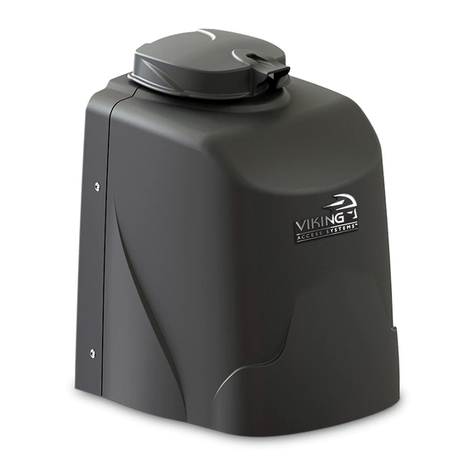
Viking
Viking F-1 User manual

Viking
Viking F-1 User manual
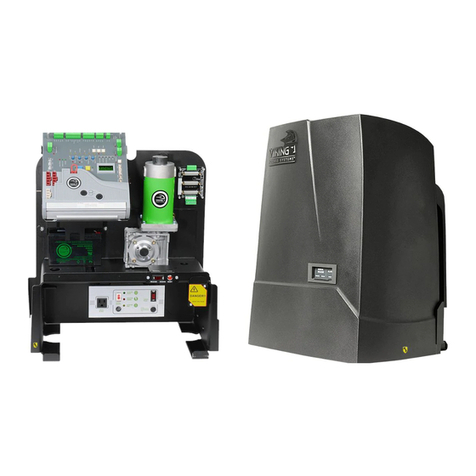
Viking
Viking L-3 User manual

Viking
Viking Q-4 User manual

Viking
Viking I-770 Original instructions
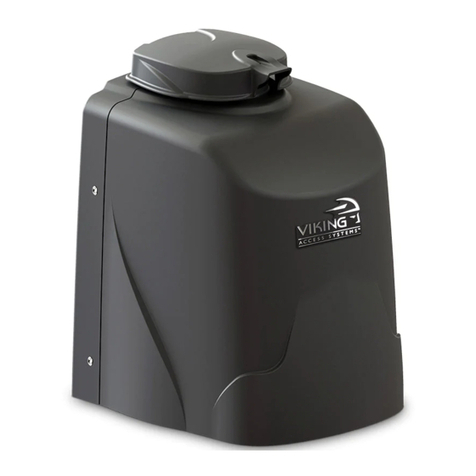
Viking
Viking F-1NX Original instructions
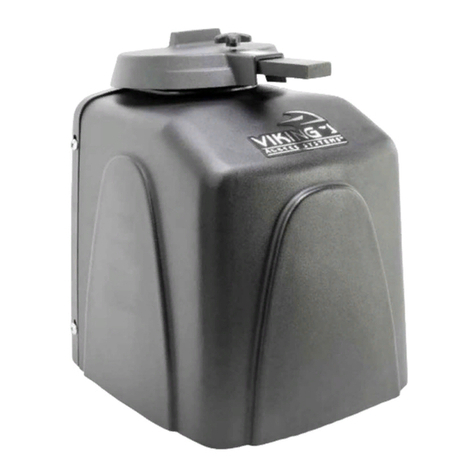
Viking
Viking R-6 Original instructions

Viking
Viking X-9S Original instructions

Viking
Viking R-6S User manual
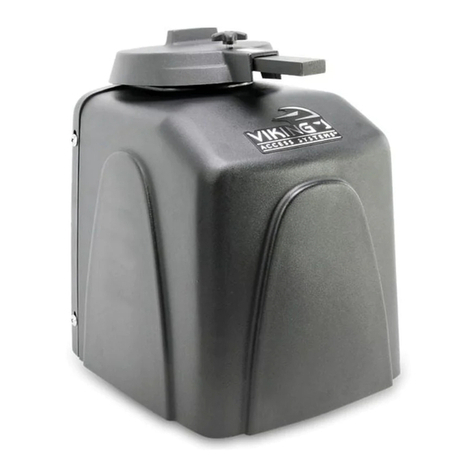
Viking
Viking R-6NX Original instructions

Viking
Viking R-6 Product information sheet

Viking
Viking X-390 User manual

Viking
Viking G-5 Original instructions
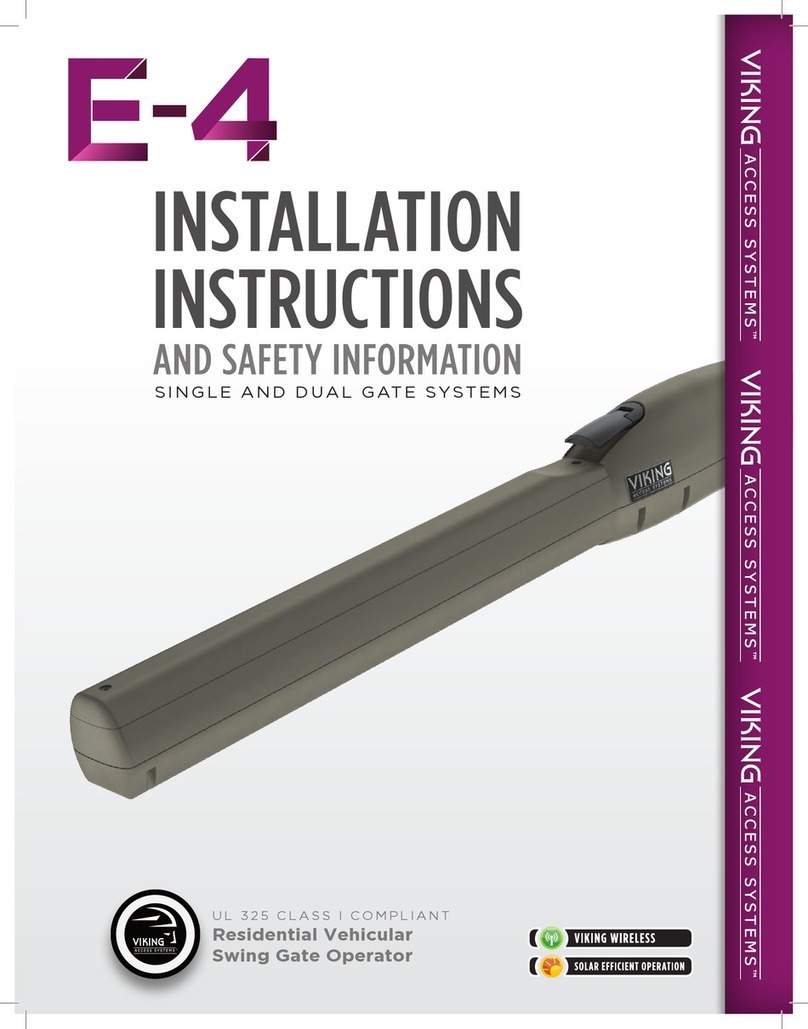
Viking
Viking E-4 User manual
